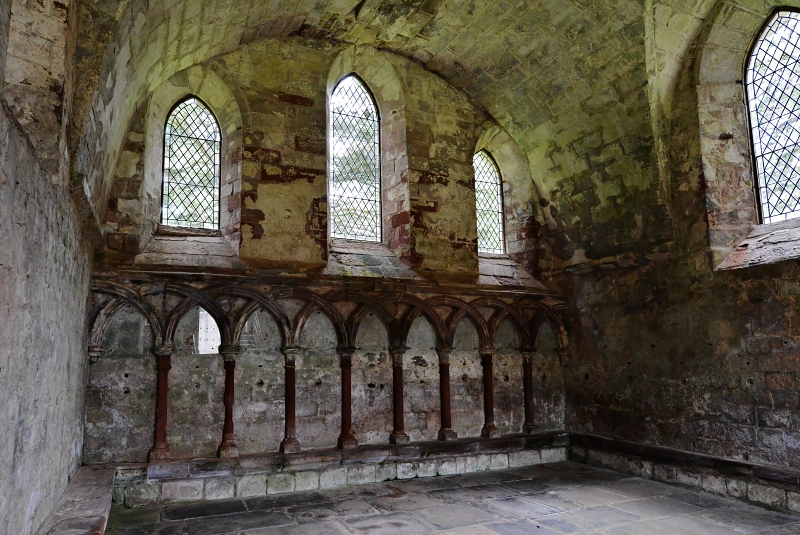
I had expected to find little left of Dryburgh, after seeing the remains of Kelso and Jedburgh, but Dryburgh far surpasses all of my expectations. Pleased to find extensive ruins here, we spread out over the grounds, each wandering on our own, coming back together from time to time to share our discoveries.
I discover the chapter house, through a carved doorway and down a flight of stairs. Stone seats line the walls and windows shed little light into this cavernous chamber. Original paint is visible on the arches that make up the vaulted ceiling – red, blue and gold chevrons. I stand in the center of the room absorbing the atmosphere. It's so quiet, so serene.
I open my eyes as a reverberating sound begins and grows. For a moment I halfway believe that I'm having a paranormal experience; it sounds like Gregorian chant, dulcet tones rising and falling. A motion overhead catches my eye – one of Dana's Bee-52's – and I realize I've been listening to the flight of the bumblebee. Laughing at myself, I climb the stairs, seeking out Robin and Dana, to share in my discovery.
They've found another chamber full of carved ceiling bosses and corbels. Yet another chamber is blocked off by a wrought iron gate and holds the bust of what looks to be the portrayal of a Roman soldier. This must certainly be one of the Earl of Buchan's additions as it is completely out of place here and looks to be no older than two- or three-hundred years old.
We spend quite a long time reading the headstones in the graveyard. I am captivated by the spelling on some of these memorials; Andrew is Androo, died is dayd. I can almost hear the family members' grief stricken voices as I wander around. Sadly, there are a large number of children's headstones here.
Set aside from the main body of headstones of one family group we come across a simple headstone bearing the name of a young woman, whose name I cannot recall. We wonder about her transgressions in life, to have been ostracized in death.
We linger longer than we should at Dryburgh; it's early evening now. This is our last night at Torwood and we need to repack. Heading back to the car, we make the decision to see Melrose Abbey in the morning on the way out of town, before we head north to our next bed and breakfast in Laurieston outside of Falkirk.
We do have another stop to make before returning to Torwood, though. We'd heard about a huge sandstone statue hidden away in the woods between Dryburgh and Scott's View and set out to find it.

Unlike the situation at nearby Melrose Abbey, with its royal patronage, Hugh de Morville, although a very wealthy noble, could not endow Dryburgh on the same scale as that of a monarch. However, it seems that King David I of Scotland was not unsympathetic to the monastery; it is recorded in a charter that the king allowed the abbey to take timber from his forests for the building work.
Hugh donated the lands of Dryburgh containing the forests, grasslands and accompanying waters, the fishings from Berwick, the churches with their lands at Mertoun and Channelkirk in his lordship of Lauderdale and Asby in Westmoreland, and the earnings from the mills of Saltoun and Lauder. His wife, Beatrice de Beauchamp, gave the income from the church at Bozeat, Northamptonshire to the abbey as well as lands at Roxburgh that she bought solely for the purpose of subsequent donation.
In around 1162 Hugh, like some other magnates of the period, turned his back on worldly affairs and entered the abbey-church, adopting the habit of the canons. He gave his elder son, Richard, his large Scottish estates while his younger son, Hugh, received those in England. Hugh, the senior, died at Dryburgh Abbey that same year.
Read more about Dryburgh Abbey at Wikipedia.